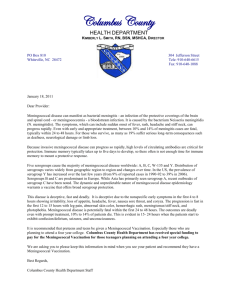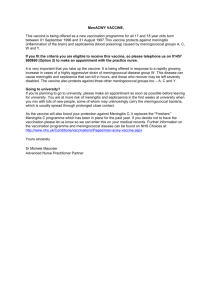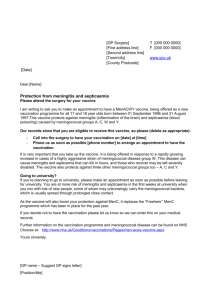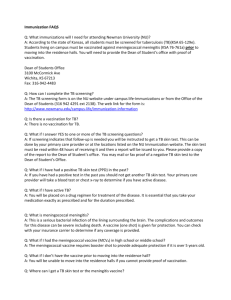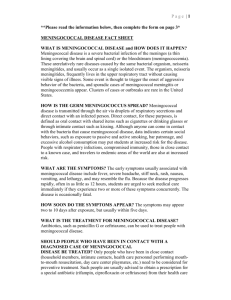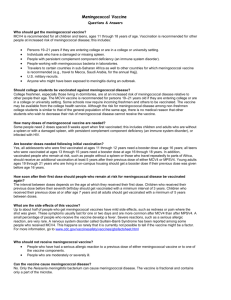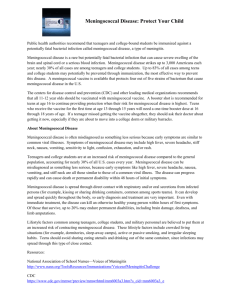Meningococcal: Questions and Answers
advertisement
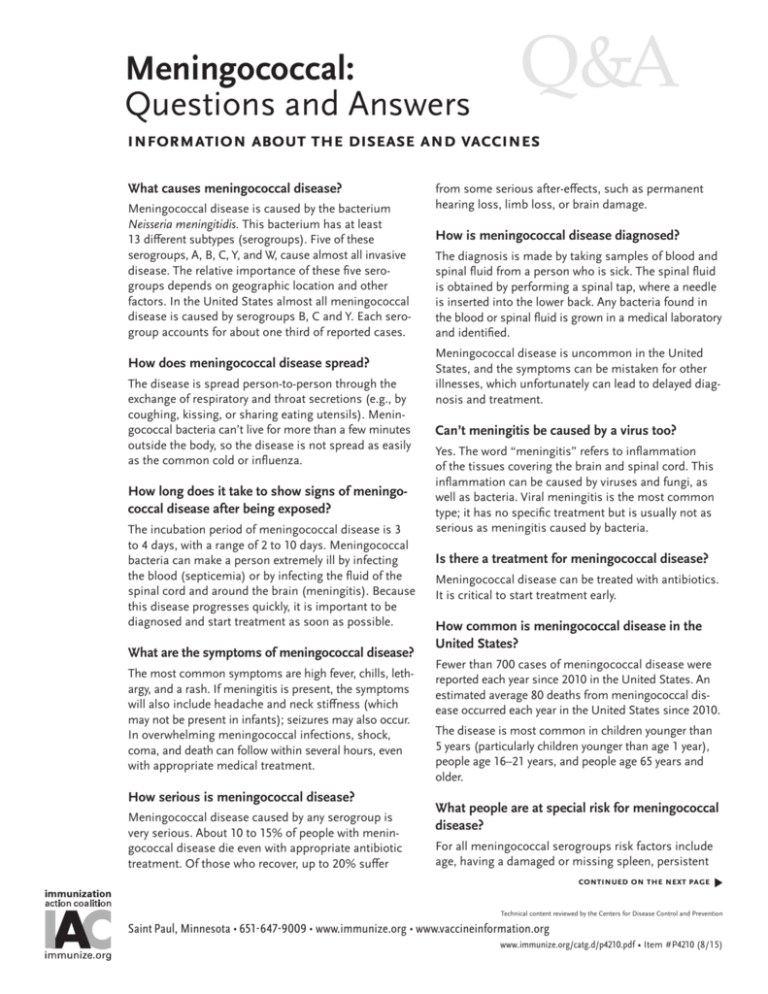
Meningococcal: Questions and Answers Q&A information about the disease and vaccines What causes meningococcal disease? Meningococcal disease is caused by the bacterium Neisseria meningitidis. This bacterium has at least 13 different subtypes (serogroups). Five of these serogroups, A, B, C, Y, and W, cause almost all invasive disease. The relative importance of these five serogroups depends on geographic location and other factors. In the United States almost all meningococcal disease is caused by serogroups B, C and Y. Each serogroup accounts for about one third of reported cases. How does meningococcal disease spread? The disease is spread person-to-person through the exchange of respiratory and throat secretions (e.g., by coughing, kissing, or sharing eating utensils). Meningococcal bacteria can’t live for more than a few minutes outside the body, so the disease is not spread as easily as the common cold or influenza. How long does it take to show signs of meningococcal disease after being exposed? The incubation period of meningococcal disease is 3 to 4 days, with a range of 2 to 10 days. Meningococcal bacteria can make a person extremely ill by infecting the blood (septicemia) or by infecting the fluid of the spinal cord and around the brain (meningitis). Because this disease progresses quickly, it is important to be diagnosed and start treatment as soon as possible. What are the symptoms of meningococcal disease? The most common symptoms are high fever, chills, lethargy, and a rash. If meningitis is present, the symptoms will also include headache and neck stiffness (which may not be present in infants); seizures may also occur. In overwhelming meningococcal infections, shock, coma, and death can follow within several hours, even with appropriate medical treatment. How serious is meningococcal disease? Meningococcal disease caused by any serogroup is very serious. About 10 to 15% of people with meningococcal disease die even with appropriate antibiotic treatment. Of those who recover, up to 20% suffer from some serious after-effects, such as permanent hearing loss, limb loss, or brain damage. How is meningococcal disease diagnosed? The diagnosis is made by taking samples of blood and spinal fluid from a person who is sick. The spinal fluid is obtained by performing a spinal tap, where a needle is inserted into the lower back. Any bacteria found in the blood or spinal fluid is grown in a medical laboratory and identified. Meningococcal disease is uncommon in the United States, and the symptoms can be mistaken for other illnesses, which unfortunately can lead to delayed diagnosis and treatment. Can’t meningitis be caused by a virus too? Yes. The word “meningitis” refers to inflammation of the tissues covering the brain and spinal cord. This inflammation can be caused by viruses and fungi, as well as bacteria. Viral meningitis is the most common type; it has no specific treatment but is usually not as serious as meningitis caused by bacteria. Is there a treatment for meningococcal disease? Meningococcal disease can be treated with antibiotics. It is critical to start treatment early. How common is meningococcal disease in the United States? Fewer than 700 cases of meningococcal disease were reported each year since 2010 in the United States. An estimated average 80 deaths from meningococcal disease occurred each year in the United States since 2010. The disease is most common in children younger than 5 years (particularly children younger than age 1 year), people age 16–21 years, and people age 65 years and older. What people are at special risk for meningococcal disease? For all meningococcal serogroups risk factors include age, having a damaged or missing spleen, persistent continued on the next page � Technical content reviewed by the Centers for Disease Control and Prevention Saint Paul, Minnesota • 651- 647- 9009 • www.immunize.org • www.vaccineinformation.org www.immunize.org/catg.d/p4210.pdf • Item #P4210 (8/15) Meningococcal: Questions and Answers (continued) page 2 of 4 complement component deficiency (an immune system disorder), and occupation as a microbiologist in a laboratory that works with meningococcal isolates. Certain groups are at increased risk for meningococcal serogroups A, C, Y, and W but not serogroup B. These risk factors include travel to places where meningococcal disease is common (such as certain countries in Africa and in Saudi Arabia), and college freshmen who live in a dormitory (see question below for more on college students). Other risk factors for serogroups A, C, Y and W include having a previous viral infection, living in a crowded household, having an underlying chronic illness, and being exposed to cigarette smoke (either directly or second-hand). How common is meningococcal disease in the world? Meningococcal disease occurs throughout the world, but is more common in the area of Africa known as the “meningitis belt.” Serogroup A is responsible for most of the meningococcal disease in sub-Saharan Africa. This serogroup is uncommon in the United States. they have had very close contact with the infected person (e.g., kissing or sharing a glass). In addition to the antibiotic treatment, vaccination may be recommended for people 2 months of age and older if the person’s infection is caused by meningococcus serogroup A, C, Y, or W-135, which are contained in 3 of the 4 meningococcal vaccines avail­able in the United States. What meningococcal vaccines are available in the United States? There are 2 types of meningococcal vaccine available in the United States. Vaccines for meningococcal serogroups A, C, W and Y are composed of polysaccharide (sugar molecules) from the surface of the meningococcal bacteria. Meningococcal vaccines in which the polysaccharide is chemically bonded (“conjugated”) to a protein produce better protection and are more effective in young children than the original polysaccharide vaccine. Vaccines for meningococcal serogroup B (MenB) are composed of proteins also found in the surface of the bacteria. Neither type of vaccine contains live meningococcal bacteria. Meningococcal polysaccharide or conjugate vaccines provide no protection against serogroup B disease and MenB vaccines provide no protection against serogroup A, C, W or Y disease. For protection against all 5 serogroups of meningococcus it is necessary to receive both vaccines. Can you get meningitis more than once? Yes. Meningitis can be caused by different serogroups of the meningococcal bacterium, by other bacteria such as Streptococcus and Haemophilus, as well as by viruses and fungi. Being vaccinated against Neisseria meningitidis or having had the disease will not protect you against Meningococcal Vaccines Licensed in U.S. meningitis from other bacteria or viruses. serogroups year If a child is diagnosed with meningococcal disease, can anything be done to protect the other children with whom he has contact? trade name type of vaccine included licensed approved ages Menomune Polysaccharide A, C, W, Y 1981 2 years and older Menactra Conjugate A, C, W, Y 2005 9 months–55 years* Menveo Conjugate A, C, W, Y 2010 2 months–55 years* MenHibrix Conjugate C, Y and Hib 2012 6 weeks–18 months Trumenba Protein B 2014 10–25 years† Individuals who have been exposed Bexsero Protein B 2015 10–25 years† to a person with bacterial men*may be given to people age 56 years or older ingitis can be protected by being †may be given to people age 26 years or older started on a course of antibiotics immediately (ideally within 24 How is this vaccine given? hours of the patient being diagnosed). This is usually recommended for household contacts and children Meningococcal polysaccharide vaccine (MPSV4) is attending the same day care or nursery school. Older given as an injection into the fatty tissue of the upper children and adults (e.g., who are in the same school arm. Meningococcal conjugate vaccines (MCV4) are or church) aren’t usually considered exposed unless given in a leg muscle of a young child or the deltoid continued on the next page � Immunization Action Coalition • Saint Paul, Minnesota • 651- 647- 9009 • www.immunize.org • www.vaccineinformation.org www.immunize.org/catg.d/p4210.pdf • Item #P4210 (8/15) Meningococcal: Questions and Answers (continued) (arm) muscle of an older child or adult. MenB vaccines are given in the deltoid muscle. Who should get the meningococcal vaccine? Certain groups should receive both MCV4 and MenB vaccines. Others are recommended to receive MCV4 only. MPSV4 is recommended only for certain people older than 55 years. MCV4 is recommended for these groups: •All children and teens, ages 11 through 18 years •People younger than 22 years of age if they are or will be a first-year college student living in a residential hall •People age 2 months and older who have a damaged or missing spleen (MenHibrix may be used for children age 6 weeks through 18 months in this group) •People age 2 months and older who have persistent complement component deficiency (an immune system disorder), or are at risk during an outbreak caused by a vaccine serogroup (MenHibrix may be used for children age 6 weeks through 18 months in these groups) •People age 2 months and older who reside in or travel to certain countries in sub-Saharan Africa as well as to other countries for which meningococcal vaccine is recommended (e.g., travel to Mecca, Saudi Arabia, for the annual Hajj). •People working with meningococcus bacteria in laboratories MenB is recommended for these groups: •People age 10 years and older who have a damaged or missing spleen •People age 10 years and older who have persistent complement component deficiency (an immune system disorder), or are at risk during an outbreak caused by a vaccine serogroup •People working with meningococcus bacteria in laboratories MenB vaccines are not routinely recommended for all adolescents or college students. However, at their June 2015 meeting ACIP voted to recommend that a MenB vaccine series may be administered to persons 16 through 23 years of age with a preferred age of vaccination of 16 through 18 years. This permissive (Category B) recommendation allows the clinician to make a MenB vaccine recommendation based on the risk and benefit for the individual patient. page 3 of 4 Should college students be vaccinated against meningococcal disease? The MCV4 vaccine is recommended for previously unvaccinated first-year college students, age younger than 22 years, who are or will be living in a residence hall. Some colleges and universities require incoming freshmen and others to be vaccinated with MCV4; some may also require that a dose of MCV4 have been given since the age of 16 years. MCV4 may be available from the college health service. Although several small MenB outbreaks have occurred on college campuses since 2013, college students in general are not at higher risk of MenB then persons of the same age who are not college students. Consequently, ACIP does not routinely recommend MenB vaccination for college students. However, college students may choose to receive MenB vaccine to reduce their risk should a MenB outbreak occur. Why doesn’t ACIP recommend MenB vaccination for all adolescents or all college students? Although a person with MenB disease can die or be permanently scarred or disabled, and may incur staggering medical expenses, MenB disease is rare and MenB vaccine is very expensive. A recommendation to vaccinate all adolescents or all college students is not cost-effective. How many doses of meningococcal vaccine are needed? For MCV4 vaccines the number of doses recommended depends on the age when the vaccine is given and the presence of certain medical conditions or risk factors. All adolescents should be vaccinated with one dose of MCV4 at ages 11 or 12 years and with a booster dose at age 16 years. All teens who were vaccinated with MCV4 at ages 13 through 15 years need a booster dose at age 16 through 18 years (at least 8 weeks after the first dose). First-year college students younger than 22 years who are living in a residential hall should get an MCV4 booster dose if their previous dose was given before age 16 years. People ages 2 months and older who have certain risk factors such as no spleen or a damaged spleen, or persistent complement component deficiency (an immune system disorder), may need more than one dose. In addition, vaccinated people who remain at risk, such as people without a spleen, microbiologists who work with meningococcus, or continued on the next page � Immunization Action Coalition • Saint Paul, Minnesota • 651- 647- 9009 • www.immunize.org • www.vaccineinformation.org www.immunize.org/catg.d/p4210.pdf • Item #P4210 (8/15) Meningococcal: Questions and Answers (continued) those who travel repeatedly to parts of Africa, should receive a booster dose of MCV4 every 5 years. A series of MenB vaccine is either 2 (for Bexsero) or 3 (for Trumenba) doses. Booster doses of MenB vaccine following the initial series are currently not recommended, including for people with no spleen or persistent complement component deficiency. How soon after their first MCV4 dose should people who remain at risk for meningococcal disease be vaccinated again? The time between the primary (initial) doses(s) of MCV4 and the first booster varies. Children who received their primary MCV4 dose(s) before their seventh birthday should get their first booster 3 years after their primary dose(s). Children who received their primary MCV4 dose(s) at or after age 7 years and all adults should get MCV4 boosters 5 years after their primary dose(s). What are the side effects of this vaccine? Up to about half of people who get meningococcal vaccines have mild side effects, such as redness or pain where the shot was given. These symptoms usually last for one or two days and are more common after MCV4 than after MPSV4. A small percentage of people who receive the vaccine develop a fever. Severe reactions, such as a serious allergic reaction, are very rare. More than 60,000 persons have received MenB vaccines during clinical trials or for outbreak control on college campuses. The most common side effect was pain at the injection site, which was reported by about 80% of recipients. The Vaccine Adverse Event Reporting System (VAERS) and other vaccine safety systems will carefully monitor MenB vaccine safety as they do for other U.S.-licensed vaccines. How effective is this vaccine? The MPSV4 vaccine is 85 percent to 100 percent effective at preventing infection from the subtypes of page 4 of 4 meningococcus found in the vaccine. Based on results of laboratory studies, MCV4 is believed to be at least as effective as MPSV4. Because of the low incidence of serogroup B meningococcal disease, MenB vaccine efficacy estimates were based on demonstration of an immune response after vaccination. From 63% to 88% of recipients of a full series of MenB vaccine develop a protective level of antibody against representative strains of serogroup B meningococcus. Who should not receive meningococcal vaccine? These groups should not receive either type of meningococcal vaccine: •People who have had a serious allergic reaction to a previous dose of either meningococcal vaccine or to one of the vaccine components. The packaging of some meningococcal vaccines may contain latex. Information on the contents of each vaccine is included with each vaccine. •People who are moderately or severely ill. Can a pregnant woman get meningococcal vaccine? Studies of vaccination with MPSV4 during pregnancy have not documented adverse effects among either pregnant women or newborns. Post-licensure safety data suggest no concerns with the safety of MCV4 during pregnancy. Pregnancy is not considered to be a contraindication to either MPSV4 or MCV4. Although experience with MenB vaccines is limited they have not been shown to be detrimental to a pregnant woman or fetus. Can the vaccine cause meningococcal disease? No. Only the Neisseria meningitidis bacterium can cause meningococcal disease. Meningococcal vaccines contain only the sugar capsule or capsule protein of the microbe. Immunization Action Coalition • Saint Paul, Minnesota • 651- 647- 9009 • www.immunize.org • www.vaccineinformation.org www.immunize.org/catg.d/p4210.pdf • Item #P4210 (8/15)
